
The Mulch
Yellow Book, Golden Year
The garden at Hen Ysgoldy (the Old Schoolhouse), near Llanfrothen, celebrates its Golden Anniversary in 2011 and it was felt that opening the gardens to the public in its 50th year would be a fitting tribute to the first and subsequent owners of the garden.
Keith Gurney, the current owner, met with local National Gardens Scheme (Yellow Book) representatives back in August 2010 to discuss the requirements for entering his garden in the scheme.
We decided to open for two days over the Bank Holiday weekend at the end of May to capitalise on the flowering period of the mature Rhododendrons, Azaleas and Camellias. As the gardener at Hen Ysgoldy this was an exciting opportunity for me to clear and renovate part of the gardens to a deadline.
This gave us nine months to prepare, repair, clear and organise as much as we could in time for the opening. We had lots of support from the local NGS representatives, Janet Jones and Grace Meirion-Jones, and other nearby garden owners.
I asked Janet to give me a list of handy tips to share with other garden owners considering opening their gardens in aid of charity: “The gardens need to have at least 45 minutes of viewing interest and there needs to be reasonable access and parking for vehicles. And make refreshments and plant sales available if at all possible. We do our best to help garden owners and welcome applications up until August for possible inclusion in the following year’s itinerary.” www.ngs.org.uk
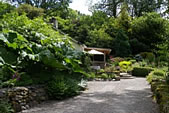 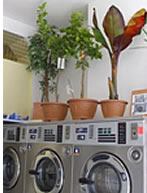 < ^ Back to School < ^ Back to School
Hen Ysgoldy opened for two days in May and provided refreshments and plant sales for visitors to the garden
Wash ‘n Grow v >
These tender exotics and
tropical plants love the
warmth and bright surroundings
of my local launderette
My Beautiful Launderette…
Some things make a winning combination: strawberries and cream, cheese and pickle, egg and cress. How about exotic plants and a launderette?
I needed somewhere to store my tender exotic plants, Strelitsia reginae (Bird of Paradise), Banana, Orange and Lemon trees, as I plan further renovation works at Garreg Gron and it occurred to me during a trip to my local launderette that it would be a perfect environment for them: it’s warm, bright and spacious.
Odessa, the shop owner, agreed to put them on display, and I keep an eye on them regularly. Their unusual leaf shapes, colours, fruits and flowers attract lots of attention and even the odd photo or two!
Tenderly Tyddyn Iolyn…
Back in March, a local B&B owner, Ann Alston, asked me to help replant a sunny bank at her farmhouse a few miles down the road from me.
It quickly became clear that Ann was also a keen plantswoman and very fond of her garden. I asked Ann to tell me more about Tyddyn Iolyn, her garden and the mild microclimate that it enjoys…
“The old Welsh farmhouse dates back to at least the early C18th and probably in parts to the C16th. To have remained standing and inhabited for all that time shows that it is in a protected place and it is certainly sheltered from prevailing winds from the west.
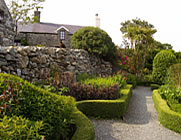 < v A Warm Welcome < v A Warm Welcome
The gardens at Tyddyn Iolyn are 300ft above sea level but many tender exotics thrive here, including Ceanothus ‘Zanzibar’ and C. ‘Trewithan Blue’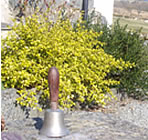 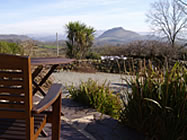
“The garden divides naturally into sections. Firstly, there is the old walled garden with a sloping easterly aspect in an area on an old map called Hen Ardd (the old garden). The depth of soil here indicates that this could well be the case. It is sheltered from the prevailing west winds and even in the two recent cold winters, my Cordyline, Penstemons, Fuchsia and Crinodendron all survived. And so did the Dahlia tubers that I never got round to lifting!
“The old Piggery behind the Bakehouse is a gravelled area with honeysuckle, geraniums, pots of Agapanthus and a fig that survived the recent winters unprotected.
“At the front of the house, which is south-facing, are a thriving Ceanothus ‘Trewithan Blue’, full of bees and hoverflies in June, and bright lime green C. ‘Zanzibar’, which lifts the spirits no end on a damp and grey winter’s day.
“Plans (and there are always plans!) include a cutting garden for flowers for the B&B, greater all year round use of the polytunnel, growing for example, strawberries and melons, developing the ‘Bonfire Field’, which is home to my two retired donkeys in the winter, tree planting for my grandson, perhaps a ‘Harry’s Wood’, a wildflower meadow, a vineyard or just a pig or two...”
Stacks of Fun…
Anyone involved in a renovation project will know that they can quickly pile up two types of packaging items: wooden pallets and those big blue plastic woven bags that get unloaded with a crane.
Rather than scrap the pallets for fire wood, I decided to put one to good use as a temporary screen to disguise an ugly concrete retaining wall.
I took photos as I constructed my new ‘vertical garden’ and have uploaded them into a step-by-step guide in a new section at: www.thegrowingcompany.co.uk > Writer.
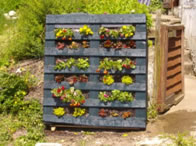 < Wooden Wonder < Wooden Wonder
This old pallet has found a new lease of life as a temporary garden screen with brightly coloured annuals, including begonia, coleus and mimosa
Femme Fatale…
Back in January I planted my favourite climbing rose next to the front door at the cottage. It had remained in its pot since I purchased it in the sale at Pocock’s near Romsey last November and managed to survive the early and vicious cold snap through December.
Rosa ‘Zephirine Drouhin’ is a Bourbon rose and is ideally suited to the westerly aspect at the front of the cottage and can cope with a range of conditions and weather that comes in off the sea from this direction.
I chose it for its easy-going nature (though I’ll train it up wiring to ensure that air can circulate around it), its deliciously enchanting and heady fragrance, its free-flowering nature and the fact that it is thornless, too.
Interestingly, and in an unplanned way, its carmine-pink double flowers add to a pink flowering theme in this part of the garden alongside Armeria maritima (Sea Thrift), Gladiolus and Geranium macrorrhizum.
 < In the Pink < In the Pink
Rosa ‘Zephirine Drouhin’ wafted its heady
fragrance into the cottage on warm
and breezy days this summer
View from the Terraces…
There are so many rocks and stones around Garreg Gron as I clear parts of the garden that I have been inventing new uses for them. On the first terrace in the back garden, I have created a new curved retaining wall, provisionally (and unimaginatively!) called ‘Terrace One and a Half’. I intend to fill it up with spare soil from another part of the garden, add a new border and create a sheltered seating area.
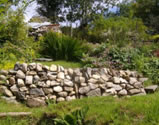 > Between a Rock and a Hard Place > Between a Rock and a Hard Place
A new terrace is taking shape in the back garden
Cuttings…
Friends Indeed
Companion planting is a proven organic method for reducing pests and diseases in salad, fruit and vegetable crops by planting something nearby that distracts, confuses or overwhelms. If you are like me, you can probably remember that marigolds should be planted next to tomatoes to repel white fly but did you know that growing chives under apple trees can prevent apple scab? Find out more at: www.figtree.org.au/companion_planting.html
Causing a Stink
An Asian ‘megapest’, the brown marmorated stink bug, Halyomorpha halys, has been chomping its way through US orchards, fields and vegetable patches since it was accidentally brought to the country in 1996. Today, it can be found in 33 of the 50 states. Although there is no shortage of predators, these stink bugs can outbreed all of them.
In Asia, they are the main prey for a parasitic wasp but this wasp is not present in significant numbers in the US. Alarmingly, the US Environmental Protection Agency (EPA) is considering introducing more of these parasitic wasps into the country and also wants to extend the use of a strong pesticide, Dinotefuran, to combat the pest. "It is so seldom that we get a pest of this magnitude that affects so many things, that it has really shifted a lot of our research activity," said Doug Pfeiffer, a professor of entomology at Virginia Tech University. "It is really a megapest compared to our native stink bugs."
Meanwhile, on comment boards, gardeners affected by the bugs have come up with an effective, cheap and organic home-made recipe: ‘Dawn’ soap diluted in water.(Article by Kerry Sheridan, AFP, 28.06.11)
Lawnmower Hiccup
A teenager from south Wales has been banned from driving after a drunken joyride on a lawnmower. Initially, he was charged with being in control of a mechanically propelled vehicle while unfit to do so, which would have carried a lesser punishment.
However, prosecuting solicitor Richie Paul argued that because the lawnmower had a motor, the offence should be classed as drink-driving. The petrol-powered machine is capable of 15mph. Magistrates agreed and handed Joel Maunder a 17-month driving ban and costs of £100. It is believed to be the first time someone in Britain has been banned for drink-driving a lawnmower. www.policespecials.com
An Apple a Day…
Greendix solar power is developing apple energy batteries that can be charged up on a solar ‘tree’ via leaf-shaped solar PV cells. The idea is that families can charge up their apples and take them to work, school or other places. “Children and parents could give energy apples to each other in the morning to start the day with extra energy”, said Joseph Lin, President. www.greendix.com
Cori Addict
Did you know that the humble Coriander (or Cilantro) is a highly effective heavy metal remover? We are hearing about the pollution in our environment, atmosphere and soils from many man-made and other sources in our news these days, so regularly adding a bunch of fresh coriander leaves to our meals might be a prudent protector of our overall health and well-being.
Here’s a recipe from Dr. David Williams for Coriander Pesto:
Process one cup fresh coriander and six tablespoons of olive oil in a blender until the coriander is finely chopped. Add one clove garlic; a half cup almonds, cashews, or other nuts, and two tablespoons lemon juice. Blend to a lumpy paste. (Add a little hot water if necessary.) www.naturalnews.com (article 09.11.09)
Mark Rendell
gardener and garden designer
____________________________________________________________
Imaginative and affordable design
and planting schemes for every kind of garden
www.thegrowingcompany.co.uk
t: 01766 530824 m: 07780 920653
|

